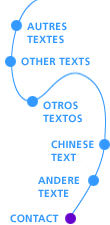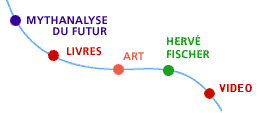 |

A worldwide first in the history of books.
"MYTHANALYSE DU FUTUR", by Hervé Fischer, 300 p.+, published directly on the Internet. http://hervefischer.montreal.qc.ca
Montreal, February 7, 2000. Here it is: the 1st ever previously unpublished book not to appear in the form of a 300-page parallelepiped of paper atoms bound in cardboard. Instead of being an object, this book is appearing directly as electronic bits, and instead of being distributed by distributors to bookstores, it is accessible over the Internet: this means that the full text is available immediately and internationally to readers, free of charge. The publication of this book was not decided on by a reading committee and publisher, but by an author..
Thanks to computers and the Internet, this fundamental transformation of conventional publishing and its commercial constraints is now a reality for every writer. We can see this as one small step marking a major turning point in the history of "books", starting with the earliest engraved stone tablets, followed by scrolls, codex, parchments, stained-glass windows, manuscripts, and printed volumes. Many other authors are sure to follow this example.
The author saw this as a logical decision for the year 2000. However, he insists he is not trying to attack anyone and admits he loves the old-fashioned charm of books.
The book.
In 20 chapters, it discusses the imagination of society, using mythanalysis, a new theoretical approach developed from sociology and psychoanalysis. The author analyzes contemporary myths that inspire middle-class ideology and major issues in the 21st century, especially the scientific and technological revolution, artificial intelligence, the Internet, globalization, and how the concepts of nature and art have developed.
A new model for the book
Published on a Website, a book is different. It becomes an open-ended and interactive work, because the author can modify and update the text in response to readers' comments or to reflect fast-moving developments in related fields. An on-line discussion forum and e-mail now offer easy, instant communication with the author and among members of the virtual community of readers, allowing the creation of a shared book.
The first publication is in French. English and Spanish versions will follow. An audio version synchronized with the text will also be offered for those who prefer or for the visually challenged, available in different languages. Hyperlinks with other sites or research data can also be considered. The author intends to explore all the new possibilities made available to him and his readers by the never-ending revolution in digital communications technology.
Copyright / copyleft
Readers may read and print the full text of this book free of charge for their own private use. However, in accordance with intellectual property law, the author reserves all reproduction and adaptation rights for commercial or public use, for all countries and all existing or future media.
The author.
Hervé Fischer has already published many books in traditional form, including Art et Communication marginale, Balland, 1974, Théorie de l'art sociologique, Casterman, 1976, L'Histoire de l'art est terminée, Balland, 1981, L'Oiseau-chat, La Presse, Montreal, 1983, Citoyens/sculpteurs, Segedo, 1993, La calle adonde llega?, Arte y Ediciones, Mexico, 1985.
Trained in philosophy, he was a student at the École Normale Supérieure in the Rue d'Ulm, and became a head university lecturer at La Sorbonne-Paris V. He has also had a successful career as an artist (Venice and Sao Paolo Biennale, Mexico City Museum of Contemporary Art, Musée d'art contemporain de Montréal, etc.). In 1985, he became passionately interested in multimedia and was involved in the 1st French-language telematic novel Marco Polo. Hervé Fischer lives in Quebec.
|
|
 |
|